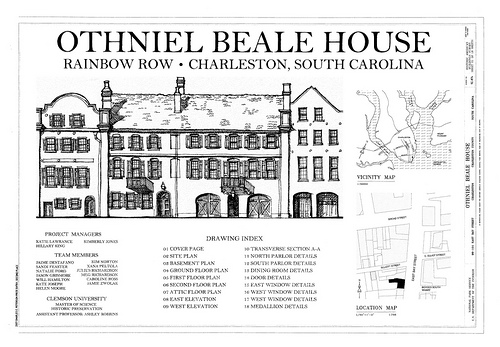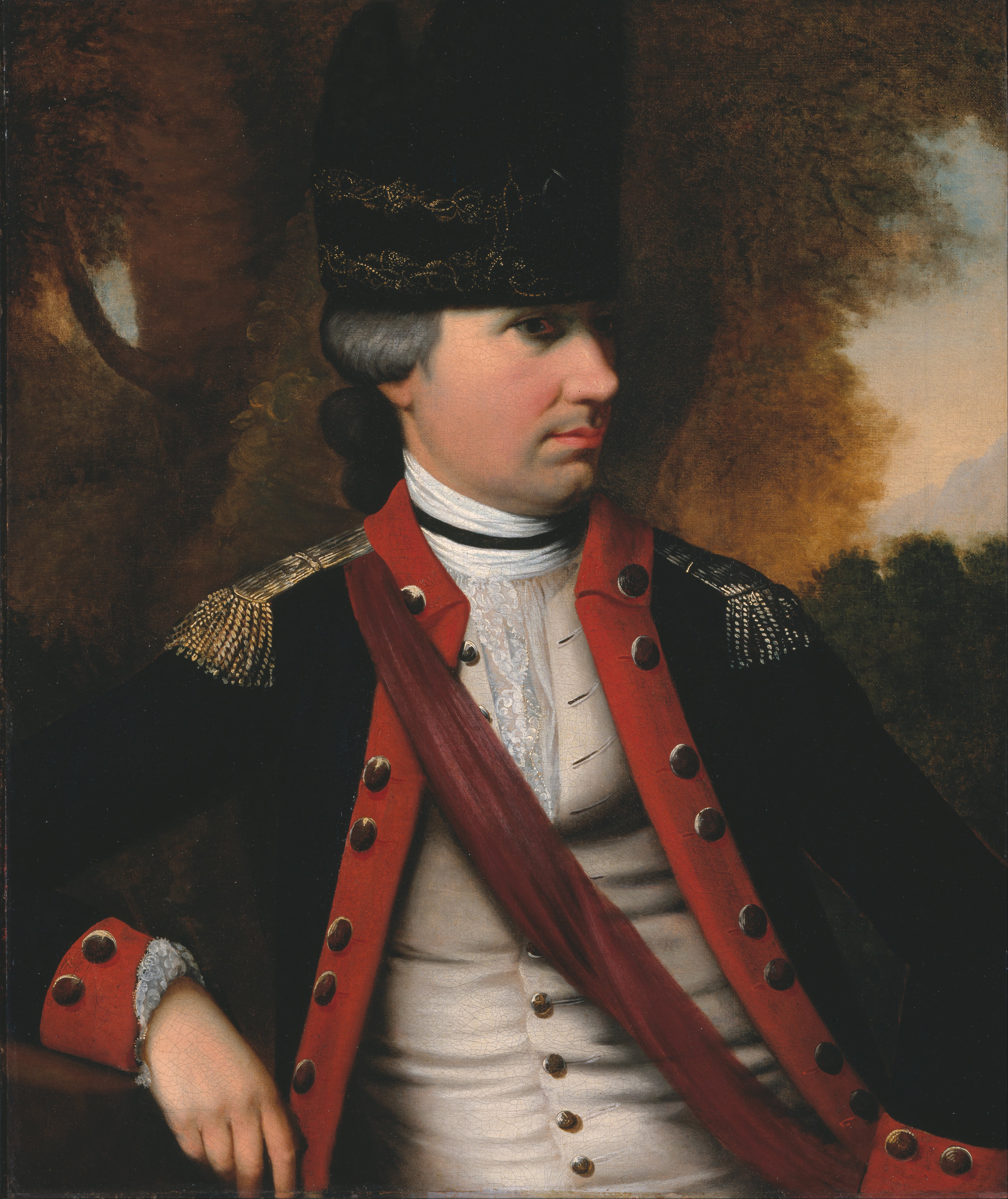|
Rainbow Row
Rainbow Row is the name for a series of thirteen colorful historic houses in Charleston, South Carolina. The houses are located north of Tradd St. and south of Elliott St. on East Bay Street, that is, 79 to 107 East Bay Street. The name Rainbow Row was coined after the pastel colors they were painted as they were restored in the 1930s and 1940s. It is a popular tourist attraction and is one of the most photographed parts of Charleston. History Rainbow Row originally fronted directly on the riverfront of the Cooper River, but that land was subsequently filled in. Merchants constructed commercial buildings with stores on the first (ground) floor and living quarters above. Most of the buildings had no interior access between the first and second floors; exterior stairs were located in the yards behind the houses. In 1778, a fire destroyed much of the neighborhood, and only 95 to 101 East Bay Street were spared. After the Civil War, this area of Charleston devolved into near slum con ... [...More Info...] [...Related Items...] OR: [Wikipedia] [Google] [Baidu] |
Charleston, South Carolina
Charleston is the largest city in the U.S. state of South Carolina, the county seat of Charleston County, and the principal city in the Charleston–North Charleston metropolitan area. The city lies just south of the geographical midpoint of South Carolina's coastline on Charleston Harbor, an inlet of the Atlantic Ocean formed by the confluence of the Ashley, Cooper, and Wando rivers. Charleston had a population of 150,277 at the 2020 census. The 2020 population of the Charleston metropolitan area, comprising Berkeley, Charleston, and Dorchester counties, was 799,636 residents, the third-largest in the state and the 74th-largest metropolitan statistical area in the United States. Charleston was founded in 1670 as Charles Town, honoring King CharlesII, at Albemarle Point on the west bank of the Ashley River (now Charles Towne Landing) but relocated in 1680 to its present site, which became the fifth-largest city in North America within ten years. It remained unincorpor ... [...More Info...] [...Related Items...] OR: [Wikipedia] [Google] [Baidu] |
Susan Pringle Frost
Susan Pringle Frost (January 21, 1873 – October 6, 1960) was the organizer and first president of the Preservation Society of Charleston. She was a leader in the suffrage movement in Charleston, South Carolina and an important proponent of the preservation of Charleston's historic buildings. Formative years Susan Pringle Frost was born in 1873 to Francis LeJau Frost and Rebecca Brewton Pringle in the Miles Brewton House, a house which her family had owned since 1765. When her family's plantations and her father's fertilizer business declined, Frost returned to Charleston from school in North Carolina and began taking stenography classes so she could help support her family. Business career and activism In 1901, Frost started working as the secretary for Bradford Gilbert, the architect for the 1901–1902 South Carolina Interstate and West Indian Exposition in Charleston, South Carolina. She began working in real estate in 1909 while she was a court reporter, and she opened he ... [...More Info...] [...Related Items...] OR: [Wikipedia] [Google] [Baidu] |
Preservation Society Of Charleston
Founded in 1920, the Preservation Society of Charleston is the oldest community-based historic preservation organization in the United States. Susan Pringle Frost founded the organization, first known as the Society for the Preservation of Old Dwellings, in 1920 along with a small group of friends. The group met on April 21, 1920, at 20 South Battery (home of Mr. and Mrs. Ernest Pringle) and voted to try to save the circa 1803 Joseph Manigault House which was slated for demolition to make way for a gas station. In 1931 the Society was instrumental in persuading Charleston City Council to pass the first zoning ordinance enacted to protect historic resources. The ordinance established the first Board of Architectural Review and designated a "Old and Historic District". The ordinance limited alterations to the exteriors of historic buildings and made provision for prosecuting violations. In 1957 the Society took on its current name to reflect an expanded mission to protect not only ... [...More Info...] [...Related Items...] OR: [Wikipedia] [Google] [Baidu] |
House Numbering
House numbering is the system of giving a unique number to each building in a street or area, with the intention of making it easier to locate a particular building. The house number is often part of a postal address. The term describes the number of any building (residential or commercial) with a mailbox, or even a vacant lot. House numbering schemes vary by location, and in many cases even within cities. In some areas of the world, including many remote areas, houses are named but are not assigned numbers. In many countries, the house number ''follows'' the name of the street; but in anglophone and francophone countries, the house number normally ''precedes'' the name of the street. History A house numbering scheme was present in Pont Notre-Dame in Paris in 1512. However, the purpose of the numbering was generally to determine the distribution of property ownership in the city, rather than for the purpose of organization. In the 18th century the first street numbering sch ... [...More Info...] [...Related Items...] OR: [Wikipedia] [Google] [Baidu] |
89 East Bay St
{{Numberdis ...
89 may refer to: * 89 (number) * Atomic number 89: actinium Years * 89 BC * AD 89 * 1989 * 2089 * etc. See also * * List of highways numbered A ''list'' is any set of items in a row. List or lists may also refer to: People * List (surname) Organizations * List College, an undergraduate division of the Jewish Theological Seminary of America * SC Germania List, German rugby union ... [...More Info...] [...Related Items...] OR: [Wikipedia] [Google] [Baidu] |
Charles Cotesworth Pinckney
Charles Cotesworth Pinckney (February 25, 1746 – August 16, 1825) was an American Founding Father, statesman of South Carolina, Revolutionary War veteran, and delegate to the Constitutional Convention where he signed the United States Constitution. He was twice nominated by the Federalist Party as its presidential candidate in 1804 and 1808, losing both elections. Pinckney was born into a powerful family of Southern planters. He practiced law for several years and was elected to the colonial legislature. A supporter of independence from Great Britain, Pinckney served in the Revolutionary War, rising to the rank of brigadier-general. After the war, he won election to the South Carolina legislature, where he and his brother Thomas Pinckney represented the landed elite of the South Carolina Lowcountry. An advocate of a stronger federal government, Pinckney served as a delegate to the 1787 Philadelphia Convention, which wrote a new federal constitution. Pinckney's influence help ... [...More Info...] [...Related Items...] OR: [Wikipedia] [Google] [Baidu] |
Othniel Beale House Rainbow Row
Othniel (; he, עָתְנִיאֵל בֶּן קְנַז, ''ʿOṯnīʾēl ben Qenaz'') was the first of the biblical judges. The etymology of his name is uncertain, but may mean "God/He is my strength" or "God has helped me". Family The Hebrew Bible refers to Othniel as "Othniel the son of Kenaz, the brother of Caleb". The expression is inconclusive in Hebrew, and has been taken to mean either that Othniel himself was the brother of Caleb, or that Othniel's father Kenaz was the brother of Caleb. The Talmud argues that Othniel was Caleb's brother. When Caleb promises the hand of his daughter Achsah to whoever conquers the land of Debir, it is Othniel who rises to the challenge, thus becoming Caleb's son-in-law. Campaign as a Judge The historical reality of events described in the Book of Judges is the subject of ongoing dispute among scholars, who vary in their opinions about how much of the book is historical. As to the story of Othniel in particular, biblical scholar Marc ... [...More Info...] [...Related Items...] OR: [Wikipedia] [Google] [Baidu] |
Lionel K , a defense in the game of bridge
{{disambiguation ...
__TOC__ Lionel may refer to: Name * Lionel (given name) Places *Lionel, Lewis, a village in the Outer Hebrides of Scotland * Lionel Town, Jamaica, a settlement Brands and enterprises * Lionel, LLC, an American designer and importer of toy trains and model railroads, which owns the trademarks and most of the product rights associated with Lionel Corp., but is not directly related * Lionel Corporation, an American manufacturer and retailer of toy trains and model railroads Other uses *Lionel (bridge) Lionel is a contract bridge bidding convention used in defense against an opposing 1NT openings. Using Lionel, over a 1NT opening of the opponents: :* a double is conventional and denotes spades and a lower suit (4-4 or longer), :* a 2/2 overcall de ... [...More Info...] [...Related Items...] OR: [Wikipedia] [Google] [Baidu] |
John Foster Dulles
John Foster Dulles (, ; February 25, 1888 – May 24, 1959) was an American diplomat, lawyer, and Republican Party politician. He served as United States Secretary of State under President Dwight D. Eisenhower from 1953 to 1959 and was briefly a Republican U.S. Senator for New York in 1949. He was a significant figure in the early Cold War era who advocated an aggressive stance against communism throughout the world. Born in Washington, D.C., John Dulles joined the leading New York law firm of Sullivan & Cromwell after graduating from George Washington University Law School. His grandfather, John W. Foster, and his uncle, Robert Lansing, both served as United States Secretary of State, while his brother, Allen Dulles, served as the Director of Central Intelligence from 1953 to 1961. John Foster Dulles served on the War Industries Board during World War I and he was a U.S. legal counsel at the Paris Peace Conference, 1919, 1919 Paris Peace Conference. He became a member of the ... [...More Info...] [...Related Items...] OR: [Wikipedia] [Google] [Baidu] |
Tourist Attractions In Charleston, South Carolina
Tourism is travel for pleasure or business; also the theory and practice of touring, the business of attracting, accommodating, and entertaining tourists, and the business of operating tours. The World Tourism Organization defines tourism more generally, in terms which go "beyond the common perception of tourism as being limited to holiday activity only", as people "travelling to and staying in places outside their usual environment for not more than one consecutive year for leisure and not less than 24 hours, business and other purposes". Tourism can be domestic (within the traveller's own country) or international, and international tourism has both incoming and outgoing implications on a country's balance of payments. Tourism numbers declined as a result of a strong economic slowdown (the late-2000s recession) between the second half of 2008 and the end of 2009, and in consequence of the outbreak of the 2009 H1N1 influenza virus, but slowly recovered until the COVID-19 ... [...More Info...] [...Related Items...] OR: [Wikipedia] [Google] [Baidu] |

%2C_numéro_56%2C_porte_02.jpg)


